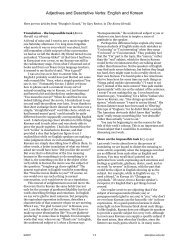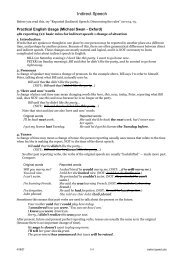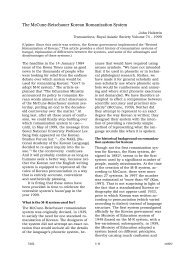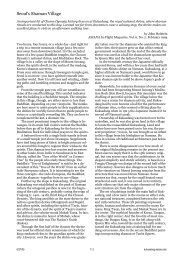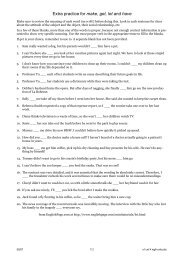Seoul's Hands-on Museum of Korean Culture - Korea Mosaic
Seoul's Hands-on Museum of Korean Culture - Korea Mosaic
Seoul's Hands-on Museum of Korean Culture - Korea Mosaic
Create successful ePaper yourself
Turn your PDF publications into a flip-book with our unique Google optimized e-Paper software.
The shops where you might have the most fun are<br />
the sec<strong>on</strong>dhand-art varieties from the old days. Feast<br />
your eyes <strong>on</strong> very good and very bad old and new<br />
ceramics, Koryo dynasty br<strong>on</strong>ze spo<strong>on</strong>s, gilt wood<br />
Bhuddas, s<strong>on</strong>orous bell-brass bowls, a rusty turn-<strong>of</strong>the-century<br />
Japanese can opener. . . a set <strong>of</strong> deer antlers<br />
These shops are a cornucopia clutter <strong>of</strong> days<br />
g<strong>on</strong>e by.<br />
. . . and the new<br />
Insa-d<strong>on</strong>g also has galleries which sell new paintings<br />
with both traditi<strong>on</strong>al and modern motifs. Buy or<br />
d<strong>on</strong>’t buy, but be sure to enjoy — many <strong>of</strong> these galleries<br />
boast <strong>of</strong> having gotten at least <strong>on</strong>e currently<br />
renowned artist started <strong>on</strong> his road to glory, and they<br />
may give you a good story or two about their progenies<br />
to take back with you.<br />
The exhibiti<strong>on</strong> posters they are producing these<br />
days are state-<strong>of</strong>-the-art in both design and printing.<br />
You might ask the owner or the artist being exhibited<br />
if you could have <strong>on</strong>e or two. These invariably<br />
friendly people will oblige you if they can. Then take<br />
it down the street and have it framed.<br />
One <strong>of</strong> the galleries is a 17th-century aristocrat’s<br />
house. Its <strong>on</strong>ly modificati<strong>on</strong> is the white display matting<br />
<strong>on</strong> the wall, and a set <strong>of</strong> s<strong>of</strong>a and chairs for<br />
guests to sit and have a chat with the artist or <strong>on</strong>e <strong>of</strong><br />
the interesting visitors who drop by from time to<br />
time. Ch<strong>on</strong> Kang-ho, who taught himself in his art,<br />
explains in English how he used epoxy and oils to<br />
fashi<strong>on</strong> his works <strong>on</strong> exhibiti<strong>on</strong> today. As he shows<br />
us around, a few students chat quietly over a cup <strong>of</strong><br />
green tea <strong>on</strong> the veranda, which opens <strong>on</strong>to the<br />
bamboo garden in back.<br />
In the pottery shops which sell new pieces is a<br />
fascinating range <strong>of</strong> traditi<strong>on</strong>al and modern designs,<br />
and even a few attempts at a synthesis <strong>of</strong> traditi<strong>on</strong>al<br />
and modern. Some <strong>of</strong> these shops have their own<br />
kilns in the provinces. One small shop specializing in<br />
tea and wine sets is run by a very nice old gentleman<br />
more than willing to impart lots <strong>of</strong> interesting details<br />
and anecdotes about how his pottery is produced.<br />
Even the household goods sold in Insa-d<strong>on</strong>g are<br />
art in themselves. In the furniture shops wardrobes<br />
and vanities shimmer with the luster <strong>of</strong> mother-<strong>of</strong>pearl<br />
emanating from under several carefully applied<br />
layers <strong>of</strong> lacquer. In the bedding shops are the silkcovered<br />
yo sleeping mats and the ibul quilts, in a<br />
festive rainbow pattern <strong>of</strong> dazzling reds, blues,<br />
greens and yellows, floral patterns <strong>of</strong> pale pastel embroideries,<br />
or print patterns in subdued or bold earth<br />
colors. In these shops you can also pick up a cushi<strong>on</strong><br />
cover in silk or cott<strong>on</strong> or hemp cloth, or have them<br />
do up a bedspread for you.<br />
How about a cheap, garish souvenir Sorry, you’ll<br />
have to look elsewhere. Instead, Insa-d<strong>on</strong>g handcraft<br />
shops <strong>of</strong>fer gifts you will later be sorely tempted to<br />
keep for yourself. Silk scarves, place mats woven<br />
from thick yarn <strong>of</strong> hemp or cott<strong>on</strong>, lacquered paper<br />
boxes for accessories and odds and ends, mulberrypaper<br />
lampshades, lacquered jewelry boxes with<br />
mother-<strong>of</strong>-pearl inlay, hand print or woodblock print<br />
general purpose greeting cards, crystal glasses, clay<br />
and wood figurines.<br />
In many smaller shops are new paintings and<br />
pottery with traditi<strong>on</strong>al motifs from all <strong>of</strong> <strong>Korea</strong>’s<br />
dynastic periods. These are crafted by younger artists,<br />
so the prices are outrageously reas<strong>on</strong>able. Many<br />
<strong>of</strong> these pieces are sublime, most are very good, and<br />
some, well. . . Every expatriate will have his story<br />
about that beauty he gave to a friend and will go to<br />
his grave kicking himself for it. Pick out a nice vase<br />
and ask the shopkeeper to make a lamp stand out <strong>of</strong><br />
it, for just a small extra charge.<br />
Even the really cheap pottery <strong>on</strong> the street carts,<br />
priced between $2 and $10, can be very good. And<br />
even something not so good can be used back home<br />
in a novel way, maybe as an exotic umbrella stand or<br />
waste c<strong>on</strong>tainer.<br />
And then there are the calligraphy shops with<br />
their fascinating brushes. Take home an ordinary<br />
eight-inch brush with bristles <strong>of</strong> horsehair, or <strong>on</strong>e <strong>of</strong><br />
goat, weasel, or ox hair. The handles <strong>on</strong> these<br />
brushes are <strong>of</strong> natural-finish bamboo, lacquer inlaid<br />
with a dusting <strong>of</strong> mother-<strong>of</strong>-pearl, or painted ox<br />
horn. You can even see a brush three feet l<strong>on</strong>g, which<br />
the artist holds like a mop as he walks across the paper<br />
he’s writing <strong>on</strong>. Keep a lookout here (and in the<br />
scroll-hanging shops) for simple unframed paintings<br />
in traditi<strong>on</strong>al motifs, d<strong>on</strong>e by struggling younger artists;<br />
you might happen <strong>on</strong> a really good <strong>on</strong>e which<br />
you can take home for under ten dollars.<br />
The traditi<strong>on</strong>al mulberry-bark papers sold in the<br />
paper shops come in a variety <strong>of</strong> whites and rich pastels,<br />
some with inlaid patterns <strong>of</strong> leaf specks or seaweed<br />
swirls or other <strong>of</strong> nature’s gifts. For centuries<br />
the whites have been applied <strong>on</strong> bamboo ribs to<br />
make the traditi<strong>on</strong>al fans, globe lanterns, and kites<br />
you can see in these shops even today. These warm<br />
whites can also serve as a very pleasant wall paper;<br />
enhance your gifts by wrapping them in the elegant<br />
pastels. And now they are finally producing c<strong>on</strong>temporary<br />
assortments <strong>of</strong> stati<strong>on</strong>ery and envelopes in<br />
the entire range <strong>of</strong> colors and patterns.<br />
Any self-respecting letter <strong>on</strong> the traditi<strong>on</strong>al stati<strong>on</strong>ery<br />
requires a pers<strong>on</strong>al seal. One shop displays<br />
an intricately carved antique seal a meter square, but<br />
you d<strong>on</strong>’t have to go that far. Tell the shopkeeper<br />
your kid’s name, or anything you would like translated<br />
into Chinese or <strong><strong>Korea</strong>n</strong> characters, and he’ll<br />
have a seal with a handle <strong>of</strong> agate, crystal, b<strong>on</strong>e, or<br />
wood ready for you in no time. D<strong>on</strong>’t forget a case <strong>of</strong><br />
the gooey red ink!<br />
No other neighborhood in Seoul comes close to<br />
lnsa-d<strong>on</strong>g’s <strong>of</strong>fering <strong>of</strong> quality traditi<strong>on</strong>al foods. You<br />
might want to start your day here with <strong>on</strong>e type <strong>of</strong><br />
meal, look around awhile, take a break at a traditi<strong>on</strong>al<br />
tea house, look around a bit more, take another<br />
rest at the traditi<strong>on</strong>al c<strong>on</strong>fecti<strong>on</strong>er’s shop, and<br />
then, after looking around some more, finish <strong>of</strong>f your<br />
adventure with another kind <strong>of</strong> meal.<br />
There are three major vegetarian restaurants in<br />
the neighborhood. All <strong>of</strong> them <strong>of</strong>fer their own versi<strong>on</strong>s<br />
<strong>of</strong> traditi<strong>on</strong>al decor, and all provide a plethora<br />
<strong>of</strong> side dishes, each <strong>on</strong>e prepared with special care,<br />
that you will not be able to do justice to. At San-kol<br />
and Bu-il you can get a thoroughly satisfying meal<br />
for around five dollars.<br />
San-ch’<strong>on</strong>’s owner, a former Buddhist m<strong>on</strong>k,<br />
brought some vegetarian delights with him from his<br />
mountain temple. Did he also bring the mellow, rich-<br />
6/27/05 2/ 3 insad<strong>on</strong>g-asiana.doc




